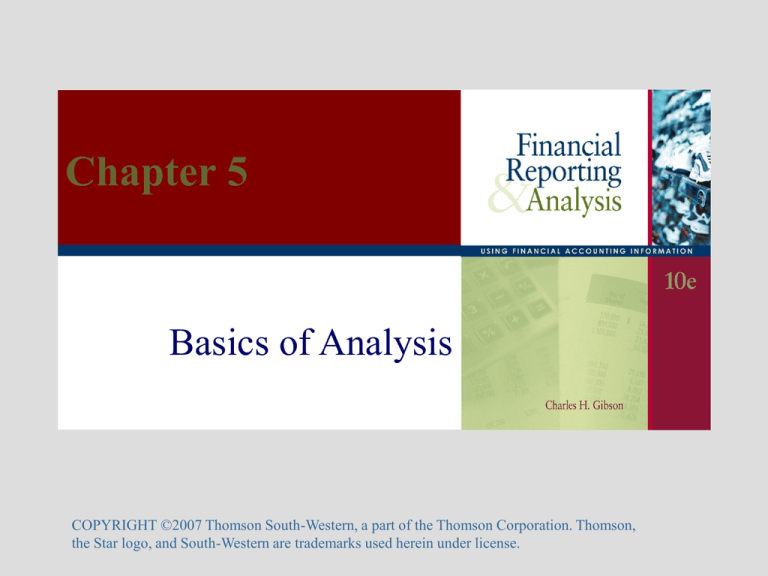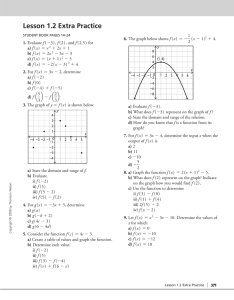
Chapter 5
Basics of Analysis
COPYRIGHT ©2007 Thomson South-Western, a part of the Thomson Corporation. Thomson,
the Star logo, and South-Western are trademarks used herein under license.
Ratio Analysis
• Liquidity
– Measures a firm’s ability to meet its current obligations
• Leverage (borrowing capacity)
– Measures the degree of protector for long-term creditors
• Profitability
– Measures the earning ability of a firm
• Investor-focused
• Cash flow
– Indicate liquidity, borrowing capacity, and profitability
Chapter 5, Slide #2
Copyright 2007 by Thomson South-Western, a part of The Thomson Corporation. All rights reserved.
Ratio Analysis
• Interpreted in comparison with
–
–
–
–
Prior ratios
Competitor ratios
Industry ratios
Predetermined standards
Chapter 5, Slide #3
Copyright 2007 by Thomson South-Western, a part of The Thomson Corporation. All rights reserved.
Complexities and Context
• Use of average data from balance sheet
accounts
– Necessary when comparing against income
statement data
– Does not
• Eliminate cyclical or seasonal variations
• Capture changes that occur unevenly throughout the year
• Analysis must be performed and understood
within the context of
– Native accounting principles
– Native business practices and culture
Chapter 5, Slide #4
Copyright 2007 by Thomson South-Western, a part of The Thomson Corporation. All rights reserved.
Common-Size Analysis
• The use of percentages is usually preferable to
the use of absolute amounts
• Vertical analysis
– All amounts of a year expressed as a percentage of
a base amount (e.g., net sales revenue, total
assets)
• Horizontal analysis
– Amounts for comparative years are expressed as a
percentage of the base year amount
Chapter 5, Slide #5
Copyright 2007 by Thomson South-Western, a part of The Thomson Corporation. All rights reserved.
Vertical Analysis
Melcher Company
Income Statement
For the Years Ended December 31
2005
2004
Sales revenue
Cost of goods sold
2003
$ 100,000
65,000
100.0%
65.0%
$ 95,000
60,800
100.0%
64.0%
$91,000
56,420
100.0%
62.0%
Gross profit
35,000
35.0%
34,200
36.0%
34,580
38.0%
Operating expenses:
Selling expense
General expense
14,000
16,000
14.0%
16.0%
11,400
15,200
12.0%
16.0%
10,000
13,650
11.0%
15.0%
Total operating expense
30,000
30.0%
26,600
28.0%
23,650
26.0%
5,000
1,500
5.0%
1.5%
7,600
2,280
8.0%
2.4%
10,930
3,279
12.0%
3.6%
3,500
3.5%
$ 5,320
5.6%
$ 7,651
8.4%
Operating Income before taxes
Taxes related to operations
Net Income
$
Each financial statement element is presented as
a percentage of a designated base.
Chapter 5, Slide #6
Copyright 2007 by Thomson South-Western, a part of The Thomson Corporation. All rights reserved.
Horizontal Analysis
Melcher Company
Income Statement
For the Years Ended December 31
2005
2004
2003
Sales revenue
Cost of goods sold
2005
2004
2003
$ 100,000
65,000
$ 95,000
60,800
$ 91,000
56,420
109.9%
115.2%
104.4%
107.8%
100.0%
100.0%
Gross profit
35,000
34,200
34,580
101.2%
98.9%
100.0%
Operating expenses:
Selling expense
General expense
14,000
16,000
11,400
15,200
10,000
13,650
140.0%
117.2%
114.0%
111.4%
100.0%
100.0%
Total operating expense
30,000
26,600
23,650
126.8%
112.5%
100.0%
5,000
1,500
7,600
2,280
10,930
3,279
45.7%
45.7%
69.5%
69.5%
100.0%
100.0%
3,500
$ 5,320
$ 7,651
45.7%
69.5%
100.0%
Operating Income before taxes
Taxes related to operations
Net Income
$
Each financial statement element is presented as a
percentage of a base amount from a selected year.
Chapter 5, Slide #7
Copyright 2007 by Thomson South-Western, a part of The Thomson Corporation. All rights reserved.
Year-to-Year Change Analysis
• Use both absolute and percentages
• Guidelines:
– When an item has value in the base year and none
in the next period, the decrease is 100%
– A meaningful percent change cannot be computed
when one number is positive and the other number
is negative
– A percent change is incomputable when there is no
figure for the base year.
Chapter 5, Slide #8
Copyright 2007 by Thomson South-Western, a part of The Thomson Corporation. All rights reserved.
Industry Variations
• Financial components vary by type of industry
• Merchandising
– Inventory is a principal asset
– Sales may be primarily for cash or on credit
• Service
– Inventory is low or nonexistent
• Manufacturing
– Large inventory holdings
– Substantial investment in plant assets
Chapter 5, Slide #9
Copyright 2007 by Thomson South-Western, a part of The Thomson Corporation. All rights reserved.
Descriptive Information
• Narrative data
– Annual report
– Trade periodicals
– Industry reviews
• Further explains the financial position of a firm
Chapter 5, Slide #10
Copyright 2007 by Thomson South-Western, a part of The Thomson Corporation. All rights reserved.
Comparisons
• Provides context for analysis of ratios and
financial data
• Common types
– Trend analysis
– SIC: Standard Industrial Classification
– NAICS: North American Industry Classification
System
– Industry averages; competitor comparisons
Chapter 5, Slide #11
Copyright 2007 by Thomson South-Western, a part of The Thomson Corporation. All rights reserved.
Comparisons: Trend Analysis
• A study of the financial history of a firm
• Longitudinal ratio comparison
– Falling
– Rising
– Relatively constant
• Highlight
– Effective management
– Evidence of problems
Chapter 5, Slide #12
Copyright 2007 by Thomson South-Western, a part of The Thomson Corporation. All rights reserved.
Comparisons: SIC
• Classifies business by industry
• Defines industries in accordance with the
composition and structure of the economy
• Coding structure
– Division
– Major group
– Industry group
– Industry
• Reported in SEC registrant filings
Chapter 5, Slide #13
Copyright 2007 by Thomson South-Western, a part of The Thomson Corporation. All rights reserved.
Comparisons: NAICS
• Joint creation of NAFTA partners: Canada,
U.S., and Mexico
• Industry is defined by similar production
processes
• Coding structure
–
–
–
–
–
Sector
Sub-sector
Industry group
NAICS industry
National industry
Chapter 5, Slide #14
Copyright 2007 by Thomson South-Western, a part of The Thomson Corporation. All rights reserved.
Comparisons: Industry
• Industry comparison complicated by highly
diversified companies
• Financial services
– Base their analysis on industry placement
– Provide composite industry data
Chapter 5, Slide #15
Copyright 2007 by Thomson South-Western, a part of The Thomson Corporation. All rights reserved.
Financial Services’ Publications
Publication
Service
Coverage
Data
The Department
of Commerce
Financial Report
Economic
Surveys Division,
Bureau of the
Census
Manufacturing,
mining, and trade
corporations
Income
statement and
balance sheet
data and
ratios
NAICS
Annual Statement
Studies
Risk
Management
Association
Manufacturing,
wholesaling,
retailing, service,
agriculture, and
construction
Common-size
financial
statements
and ratios
NAICS and SIC
Standard &
Poor’s Industry
Surveys
Standard &
Poor’s
50 North
American and
global industries
Industry writeups and
statistics
NAICS
Almanac of
Business and
Industrial
Financial Ratios
CCH, Inc.
192 industries
Corporate tax
return data
NAICS
Chapter 5, Slide #16
Copyright 2007 by Thomson South-Western, a part of The Thomson Corporation. All rights reserved.
Classification
Financial Services’ Publications (cont’d)
Publication
Service
Coverage
Data
Industry Norms
Dun & Bradstreet
and Key Business
Ratios
800 business
lines; 5 segments
Condensed
financial
statements;
ratios
[various]
98 industries
Longitudinal
financial
information
Value Line
Investment
Service
Chapter 5, Slide #17
Copyright 2007 by Thomson South-Western, a part of The Thomson Corporation. All rights reserved.
Classification
SIC
Comparisons: Caution
Ratios are subject to variance from:
• Differing data
• Inconsistent formula construction
• Optional (elective) accounting treatment
• Different fiscal year-ends
• Varying financial policies
• Inconsistent basis (before or after tax)
Chapter 5, Slide #18
Copyright 2007 by Thomson South-Western, a part of The Thomson Corporation. All rights reserved.
Relative Size of Firm
• Comparison of disparate size firms
– Capital market access
– Economy of scale (purchasing)
– Wider customer base
• Information
– Absolute: amplifies comparison difficulty
– Common-size: eliminates some of the difficulty
• Percent of market helps to define relative size
Chapter 5, Slide #19
Copyright 2007 by Thomson South-Western, a part of The Thomson Corporation. All rights reserved.
Other Resources:
Ward’s Business Directory
• Domestic and public companies
• 8-volume set
–
–
–
–
–
V1, 2, 3
V4
V5
V6-7
V8
Alphabetical listing
State and ZIP code
SIC code
State then SIC code
NAICS code then revenue
Chapter 5, Slide #20
Copyright 2007 by Thomson South-Western, a part of The Thomson Corporation. All rights reserved.
Other Resources:
Standard & Poor’s Stock Reports
• Companies listed on various stock exchanges
• Alphabetical by exchange
–
–
–
–
NYSE
American Stock Exchange
NASDAQ stock market
Regional exchanges
Chapter 5, Slide #21
Copyright 2007 by Thomson South-Western, a part of The Thomson Corporation. All rights reserved.
Other Resources:
Standard & Poor’s Register Of Corporations, Directors, And Executives
• 3-volumes
– V1
– V2§1
– V2§2
Alphabetical by firm name
Alphabetical listing of key individuals
Industries in 7 subsections
Chapter 5, Slide #22
Copyright 2007 by Thomson South-Western, a part of The Thomson Corporation. All rights reserved.
Other Resources:
Standard & Poor’s Analyst’s Handbook
• Selected income statement and balance sheet
items
• Related ratios
• Applicable to Standard & Poor’s industry group
stock price indexes
Chapter 5, Slide #23
Copyright 2007 by Thomson South-Western, a part of The Thomson Corporation. All rights reserved.
Other Resources:
Standard & Poor’s Corporation Records
• U.S. corporations
– Background information
– Detailed financial statistics
Chapter 5, Slide #24
Copyright 2007 by Thomson South-Western, a part of The Thomson Corporation. All rights reserved.
Other Resources:
America’s Corporate Families:® The Billion Dollar Directory®
• Corporate family listings
– Alphabetical
– Geographical
– SIC
• Cross-reference divisions, subsidiaries, and
ultimate parent companies
Chapter 5, Slide #25
Copyright 2007 by Thomson South-Western, a part of The Thomson Corporation. All rights reserved.
Other Resources:
D&B® Million Dollar Directory®
• Company listings
– Alphabetical
– Geographically
– SIC
Chapter 5, Slide #26
Copyright 2007 by Thomson South-Western, a part of The Thomson Corporation. All rights reserved.
Other Resources:
Directory Of Corporate Affiliates
• Corporate information
– Divisions
– Subsidiaries
– Affiliates
• Indexes
– Alphabetical
– Geographical
– SIC
Chapter 5, Slide #27
Copyright 2007 by Thomson South-Western, a part of The Thomson Corporation. All rights reserved.
Other Resources:
Thomas Register Of American Manufacturers
• Comprehensive reference
–
–
–
–
Products
Services
Company profiles
Catalog file
Chapter 5, Slide #28
Copyright 2007 by Thomson South-Western, a part of The Thomson Corporation. All rights reserved.
Other Resources:
Mergent Industrial Manual
• New York and American Stock Exchanges
–
–
–
–
–
–
History
Business
Properties
Subsidiaries
Financial statements
SIC codes
Chapter 5, Slide #29
Copyright 2007 by Thomson South-Western, a part of The Thomson Corporation. All rights reserved.
Other Resources:
Security Owner’s Stock Guide
• Published by Standard & Poor’s
• Survey of 5,300 stocks
–
–
–
–
Trading activity
Price range
Dividends
etc.
Chapter 5, Slide #30
Copyright 2007 by Thomson South-Western, a part of The Thomson Corporation. All rights reserved.
Other Resources:
Standard & Poor’s Statistical Service
• Industry statistics
–
–
–
–
–
Agriculture
Metals
Building
Transportation
etc.
Chapter 5, Slide #31
Copyright 2007 by Thomson South-Western, a part of The Thomson Corporation. All rights reserved.
Other Resources: Dividend Records
• Mergent Dividend Record
• Standard & Poor’s Annual Dividend Record
Provide dividend records of virtually publicly owned
American and some foreign companies
Chapter 5, Slide #32
Copyright 2007 by Thomson South-Western, a part of The Thomson Corporation. All rights reserved.
Other Resources:
D&B Reference Book of Corporate Managements
• Principle corporate officers
–
–
–
–
–
Year of birth
Education
Military service
Present business position
Previous positions
Chapter 5, Slide #33
Copyright 2007 by Thomson South-Western, a part of The Thomson Corporation. All rights reserved.
Other Resources:
Compact Disclosure
• Database of textual and financial information
• Annual and periodic reports filed with the SEC
• Contents
–
–
–
–
–
–
Major financial statements
Financial ratios
Institutional holdings
Insider ownership
President’s letter
Financial notes
Chapter 5, Slide #34
Copyright 2007 by Thomson South-Western, a part of The Thomson Corporation. All rights reserved.
Other Resources:
Lexis-Nexis
• Accounting, legal, newspaper, and periodical
information
• Financial statements from annual reports
Chapter 5, Slide #35
Copyright 2007 by Thomson South-Western, a part of The Thomson Corporation. All rights reserved.
The Users of Financial Statements
• Management
– Analyze information from the perspective of both
investors and creditors
• Investors
– Analysis of past and present information to project
the future prospects of the entity
• Creditors
– Short-term: focus is on current resources
– Long-term: consider the future prospects of the firm
Chapter 5, Slide #36
Copyright 2007 by Thomson South-Western, a part of The Thomson Corporation. All rights reserved.





